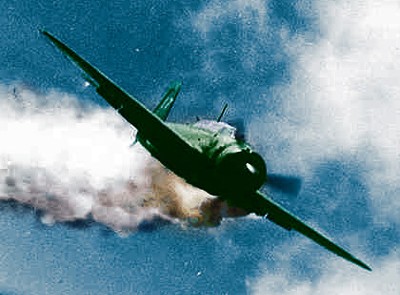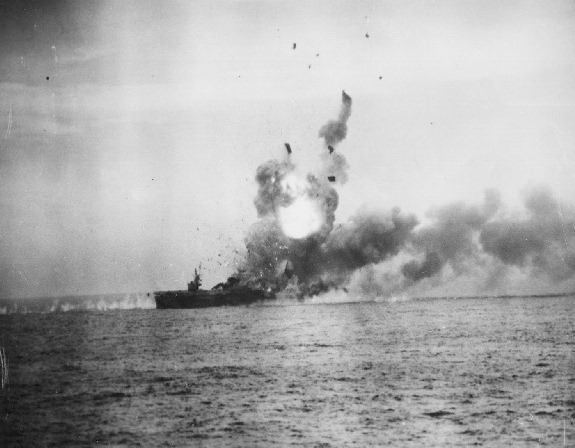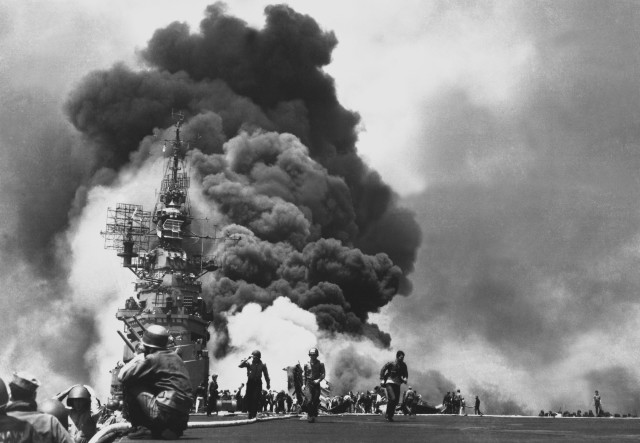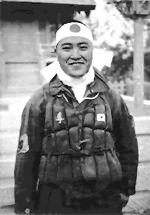“Transcend life and death. Eliminate all thoughts about your life and your death. Only then you will disregard your earthly life totally. You will be empowered to focus your attention on eradicating your enemy with unwavering determination. In the meantime, reinforce your excellence in flight skills.”
Text from the manual of the Kamikaze pilots, located in their cockpits.


The Kamikaze strike resulted in massive fires that led to an explosion in the ship’s bomb magazine. The carrier sunk within an hour. Kamikaze pilots scored several direct hits that day. They caused severe damage to other warships of the Allies as well.
Ensign Kiyoshi Ogawa, who flew his aircraft into the USS Bunker Hill
The average Kamikaze pilot was a university student. Loyalty to the Japanese Emperor, family, and nation were his key motivations. He was in his early 20s and pursuing science. He prepared for his worthy destiny by writing farewell poems and letters to his loved ones, receiving a 1000-stitch sash, and taking part in a final ceremony.
The 1000-stitch sash was a garment in which thousand different women put in one symbolic stitch each. The final ceremony included a drink of spiritual concoction that’d ensure success in the mission. Then, he’d wedge himself between 500-pound bombs.

Calls for Kamikaze pilots received a great response. For every available Japanese plane, there were three applicants. Experienced pilots were refused the chance to become Kamikaze pilots because they were needed to train the raw volunteers.
Like other regular military personnel, the Kamikaze pilots were also indoctrinated with the following oath:
- Loyalty is your obligation.
- Propriety is your way of life.
- You must esteem military valor highly.
- You must have the highest regard for righteousness.
- You must live a simple life.
The Mitsubishi A6M2, nicknamed the Zero, was the Kamikaze pilot’s premium machine. Its range was a decent 1,930 miles. The Zero could hit a maximum speed of 332 mph. This flying coffin was almost 30 feet long, and its wingspan was about 39 feet. The Japanese modified this aircraft to accommodate one 500-pound bomb.
The Zero had been the main strike plane during the Pearl Harbor attack. But other sophisticated planes forced the Zero to this humble role. And you can take many Pearl Harbor tours that show the destruct the Kamikaze attacks can truly cause.
April 6, 1945, is perhaps, the biggest day in terms of Kamikaze attacks in WWII. Over 350 Kamikaze aircraft made a desperate dive at the Allied fleet in the crucial Battle for Okinawa. This simultaneous Kamikaze wave drove several Allied sailors almost insane.
Twenty Kamikaze aircraft made a simultaneous lunge toward USS Laffey. Her gunners took out nine within seconds, but six rammed into her. Fortunately, the USS Laffey had a world-class Commanding Officer. The ship came back to fight in the Korean War.
USS Laffey Kamakaze attacks featured on The History
channel "Dogfights"
The USS Laffey is in Charleston South Carolina
at Patriots Point as a Museum ship
Although Kamikaze attacks dominated the final Japanese defense of
Okinawa, the Allies gained victory at a heavy price. The Allies lost
almost 13,000 personnel but killed 110,000 Japanese in this operation.
Imperial Japan had set aside several thousand Kamikaze planes in the
event of an attack on the Japanese mainland.Little Boy (Hiroshima) and Big Man (Nagasaki) ensured that this wouldn’t be necessary. Kamikaze pilot trainees are alive even today 70 years after the war to tell the tale.







Very interesting history. Before your post, I only knew the Kamikaze as a very good drink that I indulged too much in college.
ReplyDeleteHey Momma Fargo;
ReplyDeleteI never tried the kamakaze drink, even when I was in the service, lol it was just beer for me....liquor cost more per ounce ;)
The book "Hell to Pay", by DM Giangreco, covers the Japan invasion plans, and what they had waiting for the Allies.
ReplyDeleteHis conclusion was the invasion would probably have failed. Our military head was pushing to save all the atom bombs to use against the landing zones. We thought they were out of planes and gasoline, because they were saving it all to fight the invasion fleets. They also knew that wooden planes were invisible to radar. IIRC, 1/3 of the 15,000 (!!!) planes were wooden training types.
The list of bad news just goes on and on. In addition, their high command was expecting to loose 1/2 their population to fight off the invaders. That's about 20 million. Both sides dodged a bullet by dropping those two bombs when we did. Our casualties could have been near 5 million. I suspect lots of DC streetlights would have ended up adorned with politicians if that had happened.
Hey Will;
DeleteYou are correct, I remembered seeing pictures of Japanese soldiers showing the Japanese civilians how to use bamboo spears to fight the invaders as they landed. It would have been bloody and we would have had to invade.
USS LAFFEY is worth seeing...
ReplyDeleteHey Old NFO;
DeleteYeap, the Patriots Point museum has done a steller job with the Laffey, I don't know if they are catching flack about the U.S.S Yorktown still. Apparently a few years ago, the Navy visited the Yorktown and were very displeased and threatened to seize the Yorktown and turn her into a reef or something.